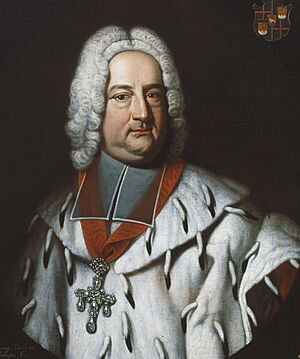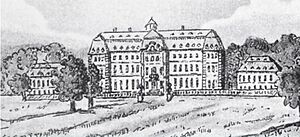Franz Georg von Schönborn facts for kids
Quick facts for kids Franz Georg von Schönborn |
|
|---|---|
| Archbishop-Elector of Trier | |

Portrait by an unknown artist, c. 1740
|
|
| Church | Catholic Church |
| Archdiocese | Trier |
| In Office | 1729–1756 |
| Predecessor | Francis Louis of Palatinate-Neuburg |
| Successor | Johann Philipp von Walderdorff |
| Personal details | |
| Born | 15 June 1682 |
| Died | 18 January 1756 (aged 73) |
Franz Georg von Schönborn was an important German nobleman. He lived from 1682 to 1756. He became the Archbishop and Elector of Trier in 1729. This meant he was both a powerful church leader and a ruler of a territory. Later, in 1732, he also became the Prince-Bishop of Worms and the Prince-Provost of Ellwangen. These were also important roles combining church and political power.
Contents
Early Life and Education
Franz Georg was born in Mainz. He was the ninth son of the Count of Schönborn. His uncle, Lothar Franz von Schönborn, was also a very important church leader. He was the Archbishop-Elector of Mainz. Franz Georg had three brothers who also became important churchmen.
Starting in 1702, Franz Georg studied many subjects. He learned about law, philosophy, and history. He studied in cities like Salzburg, Siena, and Leiden. After finishing his studies, he traveled to places like the Vatican, Spain, and England.
Rise to Power
Franz Georg's uncle helped him a lot. Through his uncle, he made important friends. These friends were in the court of the Holy Roman Emperor in Vienna.
In 1729, his uncle passed away. The Archbishop-Elector of Trier, Franz Ludwig, then took his uncle's place. This left the position of Archbishop of Trier open. Franz Georg was chosen by everyone to be the new Archbishop of Trier. This also made him the Prince-Elector of Trier.
Because the Pope supported him, he gained more power. In 1732, he was also chosen to be the Prince-Bishop of Worms. At the same time, he became the Prince-Provost of Ellwangen Abbey.
Political Views and Projects
Franz Georg chose to support the House of Habsburg. This family was very powerful at the time. Because of this choice, the Archbishopric-Electorate of Trier became involved in big conflicts.
Later in his time as ruler, Franz Georg stepped back from politics. He started to focus more on managing his lands. He also spent a lot of time on building projects.
From 1737 to 1753, he built a beautiful Baroque style home in Ellwangen. In 1739, he began to make the Philippsburg palace in Koblenz bigger. He also built a new summer home called Schönbornslust. In Worms, he continued rebuilding the Bischofshof palace. His predecessor had started this project.
Focus on Education and Legacy
Franz Georg was a very religious person. But he also worked hard to improve education for everyone. He made some changes to old traditions. For example, he stopped certain pilgrimages and holidays. He also ended some exorcism practices.
Towards the end of his life, his family's power began to lessen. Franz Georg passed away in Philippsburg in 1756. He was buried in the Cathedral of Trier.
Images for kids







